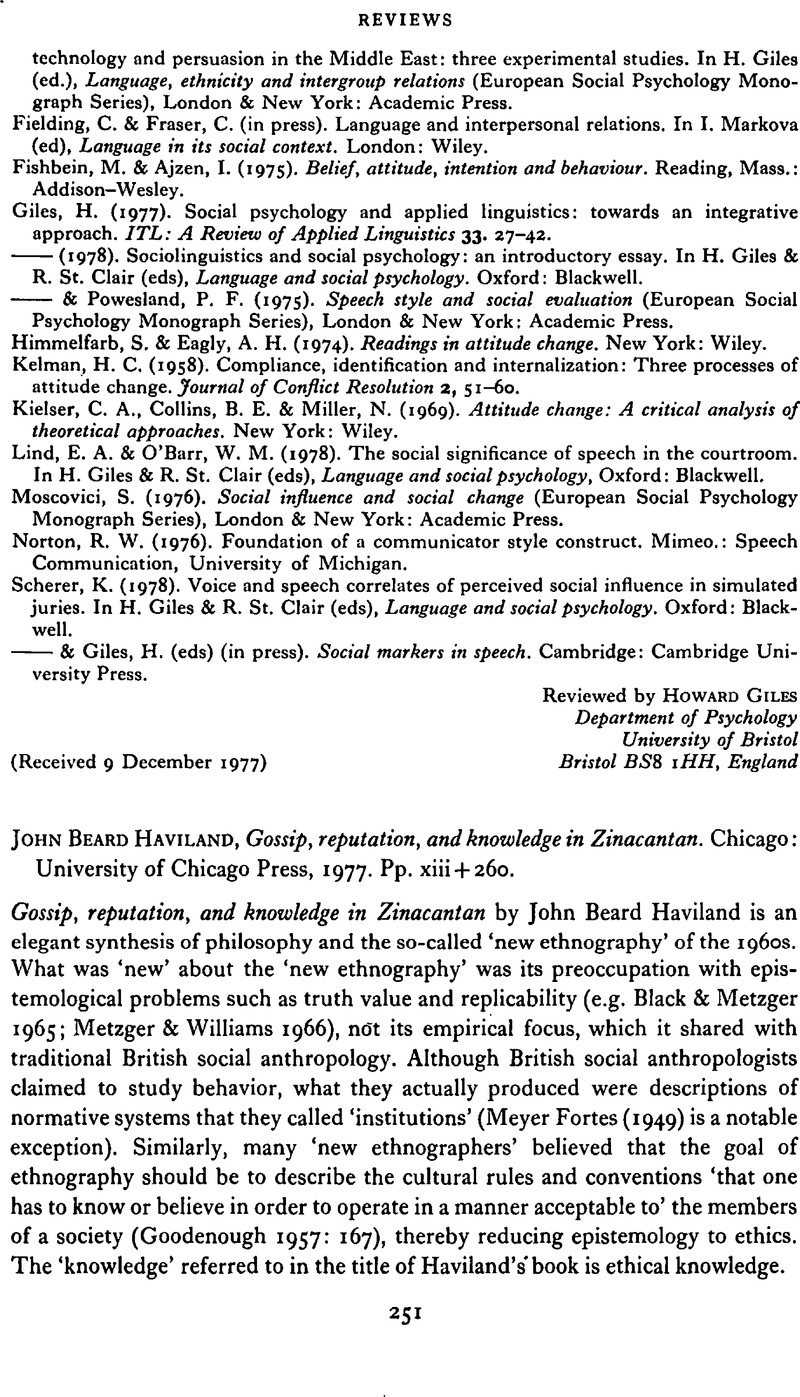No CrossRef data available.
Article contents
John Beard Haviland, Gossip, reputation, and knowledge in Zinacantan. Chicago: University of Chicago Press, 1977. Pp. xiii+260.
Published online by Cambridge University Press: 18 December 2008
Abstract
An abstract is not available for this content so a preview has been provided. Please use the Get access link above for information on how to access this content.

- Type
- Book Review
- Information
- Copyright
- Copyright © Cambridge University Press 1978
References
REFERENCES
Bauman, R. & Sherzer, J. (eds) (1974). Explorations in the ethnography of speaking. Cambridge: Cambridge University Press.Google Scholar
Bauman, R. & Sherzer, J. (1975). The ethnography of speaking. Annual review of anthropology 4. 95–119.CrossRefGoogle Scholar
Black, M. & Metzger, D. (1965). Ethnographic description and the study of law. In Nader, L. (ed.), The ethnography of law (Special publication of the American Anthropologist, Part 2 of 67 (6)), 141–65.Google Scholar
Brandt, R. B.Hopi ethics: A theoretical analysis. Chicago: University of Chicago Press.Google Scholar
Cancian, F. (1975). What are norms? A study of beliefs and action in a Maya community. Cambridge: Cambridge University Press.Google Scholar
Firth, R. (1954). Social organization and social change. Journal of the Royal Anthropological Institute 84. 1–20.Google Scholar
Fortes, M. (1949). Time and social structure: an Ashanti case study. In Fortes, Meyer (ed.), Social structure: Studies presented to A. R. Radcliffe-Brown. Oxford: Clarendon Press.54–84.Google Scholar
Geertz, C. (1957). Ritual and social change: a Javanese example. American Anthropologist 59. 32–54.CrossRefGoogle Scholar
Goodenough, W. H. (1957). Cultural anthropology and linguistics. In Garvin, P. L. (ed.), Report of the Seventh Annual Round Table Meeting on Linguistics and Language Study (Georgetown University Monograph Series on Languages and Linguistics 9). Washington, D.C.167–73.Google Scholar
Goodenough, W. H. (1965). Rethinking status and role. In Banton, M. (ed), The relevance of models for social anthropology (Association of Social Anthropologists of the Commonwealth: ASA Monographs I). London: Tavistock Publications. 1–22.Google Scholar
Hale, K. (1969). Some questions about anthropological linguistics: the role of native knowledge. In Hymes, D. (ed.), Reinventing anthropology, 382–97. New York: Random House.Google Scholar
Hymes, D. H. (1962). The ethnography of speaking. In Gladwin, T. & Sturtevant, W. C. (eds), Anthropology and human behavior. Washington, D.C.: Anthropological Society of Washington. 13–53.Google Scholar
Hymes, D. H. (1971). Sociolinguistics and the ethnography of speaking. In Ardener, E. (ed.), Social anthropology and linguistics. (Association of Social Anthropologists of the Commonwealth: ASA Monographs, 10). London: Tavistock Publications. 47–93.Google Scholar
Keesing, R. M. (1967). Statistical models and decision models of social structure: a Kwaio case. Ethnology 6. 1–16.CrossRefGoogle Scholar
Metzger, D. G. & Williams, G. E. (1966). Some procedures and results in the study of native categories: Tzeltal ‘firewood’. American Anthropologist 68, 389–407.CrossRefGoogle Scholar
Radcliffe-Brown, A. R. (1940). On social structure. Journal of the Royal Anthropological Institute 70. 1–12.Google Scholar




